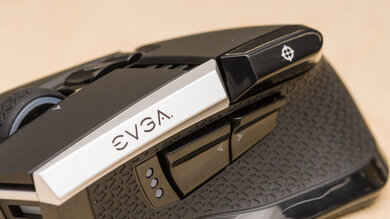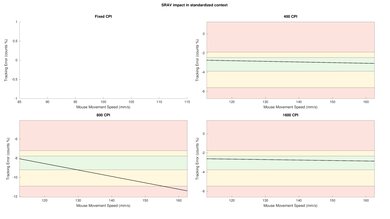The EVGA X17 is a wired gaming mouse that feels well-built and has a comfortable, right-handed shape with a thumb rest and soft-touch sides. It also has a scroll wheel with L/R tilt buttons, dedicated buttons for cycling profiles and CPI settings, and three side buttons on the left, including a sniper button. It's well-suited for all grip types and most hand sizes. Performance-wise, it has low click latency and a wide CPI range you can adjust by increments of 50. It has a maximum polling rate of 8000Hz, which some users may find produces more fluid cursor movement. It also has two lift-off distance sensors, which EVGA claims can provide lower lift-off distances, but this also falls outside our current tests. Unfortunately, the sensor on our unit is inconsistent.
Our Verdict
The EVGA X17 is satisfactory for office and multimedia work, but it isn't intended for this use. It feels well-built and has a comfortable right-handed shape suitable for all grip types and most hand sizes. You can also program all the buttons, and its scroll wheel has L/R tilt inputs for horizontal scrolling, a rare feature on gaming mice. Unfortunately, there's no way to connect it wirelessly, and the scroll wheel lacks a free-scrolling mode.
- Feels well-built.
- Comfortable right-handed shape with a thumb rest.
- Scroll wheel lacks a free-scrolling mode.
- Wired-only.
The EVGA X17 is a good FPS gaming mouse. It feels well-built and has a comfortable, right-handed shape suitable for all grip types and most hand sizes. However, it isn't suitable for small hands using any grip type or medium-sized hands using a fingertip grip. Performance-wise, it has good click latency, a very high maximum polling rate of 8000Hz, a very low lift-off distance, and you can adjust the CPI precisely by increments of 50 within a broad range. Unfortunately, it's heavy even without its added weights, and its braided cable isn't very flexible. The sensor on our model is also fairly inconsistent and undershoots the set CPI considerably during faster movements.
- Feels well-built.
- Comfortable right-handed shape with a thumb rest.
- Maximum polling rate of 8000Hz.
- Braided cable isn't very flexible and retains kinks.
- Heavy.
The EVGA X17 is a great mouse for MMO gaming, but it doesn't have as many buttons as a dedicated MMO gaming mouse. That said, you can program all the buttons using the customization software. It also feels well-built and has a comfortable shape suitable for all grip types and most hand sizes. Performance-wise, it has good click latency, a very high maximum polling rate of 8000Hz, a very low minimum lift-off distance, and you can adjust the CPI precisely by increments of 50 within a broad range. Unfortunately, it has a fairly stiff cable, and the sensor on our unit is fairly inconsistent.
- Feels well-built.
- Comfortable right-handed shape with a thumb rest.
- Maximum polling rate of 8000Hz.
- Braided cable isn't very flexible and retains kinks.
The EVGA X17 scores decently for ultra-light gaming, but it's considerably heavier than dedicated ultra-lightweight gaming mice, even without any of its extra weights installed. That said, it feels well-built and has a comfortable shape suitable for all grip types and most hand sizes. It has good click latency, a very low lift-off distance, a high maximum polling rate of 8000Hz, and you can adjust the CPI by increments of 50 within a broad range. Unfortunately, its braided cable isn't very flexible, and the sensor on our unit is fairly inconsistent.
- Feels well-built.
- Comfortable right-handed shape with a thumb rest.
- Maximum polling rate of 8000Hz.
- Braided cable isn't very flexible and retains kinks.
- Heavy.
The EVGA X17 is inadequate for travel as it's bulky and may not fit in most laptop cases. It's also a wired-only model without any wireless connection options, making it cumbersome to use in smaller spaces like buses, trains, or planes.
- Feels well-built.
- Wired-only.
- Bulky; may not fit in most laptop cases.
Changelog
- Updated Sep 28, 2022: We've converted this review to Test Bench 1.2. This update simplifies our Weight test and expands on our CPI test from Test Bench 1.1, resulting in changes to test results in both sections. For more details, you can see our complete changelog here.
- Updated Sep 21, 2022: We've converted this review to Test Bench 1.1. This update revamps our Click Latency test and results in changes to test results. For more details, you can see our full changelog here.
- Updated Sep 20, 2021: Review published.
- Updated Sep 15, 2021: Early access published.
Check Price
Differences Between Sizes And Variants
The EVGA X17 gaming mouse we tested is black, but there's also a gray color variant available. You can see the label for our unit here.
Popular Mouse Comparisons
The EVGA X17 gaming mouse is a good mid-range gaming mouse and one of EVGA's three new X series mice. It's one of only a handful of mice available at this point that offers a maximum polling rate of 8000Hz, which should provide somewhat more fluid-feeling mouse movements. Also, in addition to its primary PixArt PMW3389 sensor, it has a pair of dedicated LOD sensors that EVGA claims can achieve lower and more precisely customizable lift-off distances. This mouse has a fairly aggressive gamer aesthetic that may not be for everyone. Unfortunately, the sensor on our unit is fairly inconsistent for a mouse at this price point.
For more recommendations, see our picks for the best mouse, the best gaming mouse, and the best wired mouse.
The EVGA X17 and the EVGA X20 are similar FPS gaming mice belonging to the same lineup. The X17 is a wired-only model that's lighter but also includes a set of additional weights for adjusting the weight distribution. It also has a higher maximum polling rate of 8000Hz. On the other hand, the EVGA X20 connects wirelessly with its USB receiver or Bluetooth, or you can connect it with its charging cable. It also has a more consistent sensor. Both mice have a pair of extra lift-off distance sensors EVGA claims can provide much lower lift-off distances than other gaming mice. However, this feature doesn't work as intended on the X20 we tested, and the X17 has a lower lift-off distance despite using the same technology.
The EVGA X15 and the EVGA X17 are similar mice from the EVGA X lineup; however, the X15 is designed for MMO gaming, and the X17 is better suited for FPS gaming. The X17 comes with five additional weights to optimize the weight of the mouse, and it has two lift-off sensors on the bottom, meaning you can adjust the lift-off distance in the companion software. Also, the X17 has a sniper button and a thumb rest, and medium hands should be able to use it comfortably. On the other hand, the X15 has many more programmable inputs thanks to its ten-button side panel. Although both mice use the same sensor model, our X15 unit tends to overshoot the set CPI a fair amount, while the X17 tends to undershoot the set CPI by a similar amount.
The ROCCAT Kone Pro is a better wired gaming mouse than the EVGA X17. The ROCCAT is much lighter and feels sturdier. It also has a much more flexible cable and mouse feet that glide more smoothly. Performance-wise, it has a higher maximum CPI, a more consistent sensor, and lower click latency. On the other hand, the EVGA has a higher maximum polling rate and four extra buttons, including an additional side button and L/R mouse wheel tilt buttons. Both mice are suitable for all grip types, but the ROCCAT is slightly more accommodating for more hand sizes.
The Cooler Master M711 is an excellent, wired ultra-light gaming mouse, while the EVGA X17 is a good wired gaming mouse. The Cooler Master is much lighter and feels sturdier. It also has a much more flexible cable and better quality mouse feet that glide more smoothly. Performance-wise, it has a much higher maximum CPI range and a more consistent sensor. On the other hand, the EVGA has a thumb rest, a lower minimum CPI, a higher maximum polling rate of 8000Hz, and you can adjust the CPI more precisely. It also has four additional reprogrammable buttons, including one additional side button and a scroll wheel with L/R tilt buttons.
Test Results

The EVGA X17 gaming mouse has a set of five 5g weights that you can install under a plate on the bottom of the mouse. Unfortunately, you can only install these weights at the rear of the mouse, so you can't use them to adjust the weight distribution.
You can program all of the buttons on the EVGA X17 mouse, but the software forces you to have a button set as a left-click button at all times, and you can't reprogram the scroll wheel up/down inputs. You can set custom control profiles and five CPI settings per profile. The button marked with a "P " behind the scroll wheel is a profile cycle button by default, while the button below it marked "D" cycles between CPI settings for the profile you're using. There's also a cluster of three LED lights on the left that use color codes to indicate the CPI setting you've selected.
The polling rate options on the EVGA X17 gaming mouse are 125Hz, 250Hz, 500Hz, 1000Hz, 2000Hz, 4000Hz, and 8000Hz. We performed our tests at the maximum setting of 8000Hz. The sniper button on the left side of the mouse shifts the set CPI to 400 by default, but you can adjust this setting using the customization software. Unfortunately, the sensor on our unit is fairly inconsistent. It overshoots the set CPI by 3.7% during slow movements and undershoots by 11.22% during faster movements.
Note: In addition to its primary sensor, this mouse has two lift-off sensors on the underside of the mouse. EVGA claims these can provide a lift-off distance as low as 0.4mm, but this isn't something we can confirm with our current test methodology.
The EVGA X17 doesn't have a compatible version of the customization software for macOS, so you can't create custom profiles, so the profile switching button is unfortunately useless for Mac users. However, the default functionality of all other buttons on the EVGA X17 works fine.














